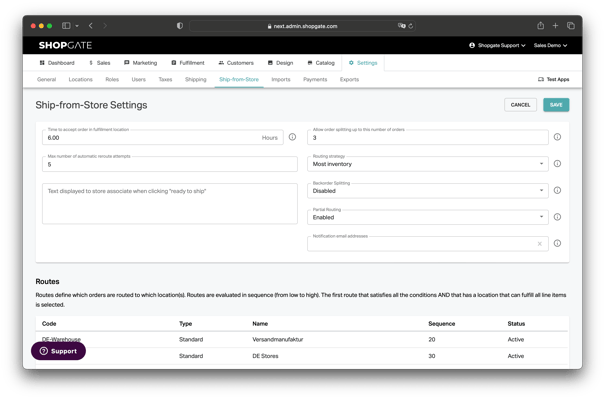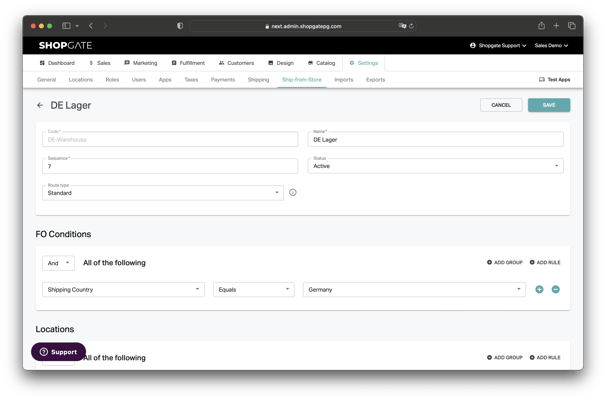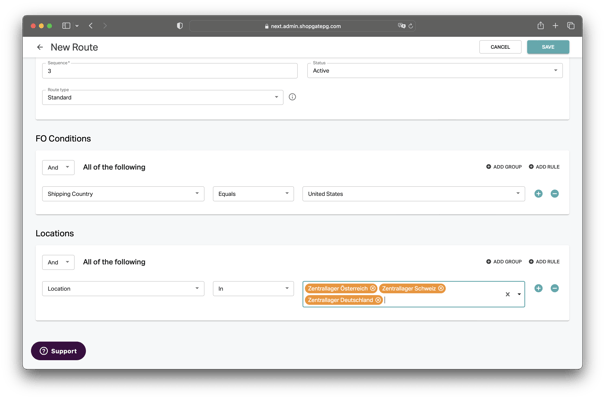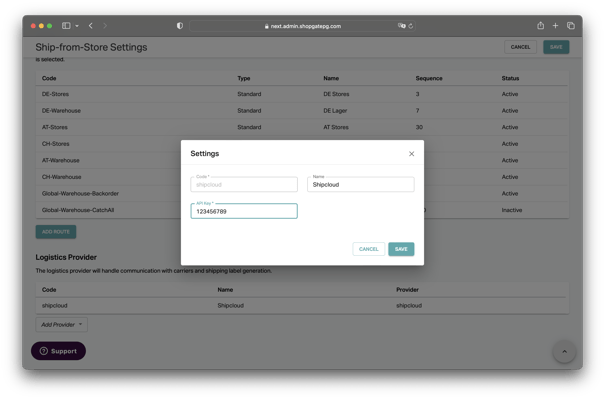Ship-from-Store Settings

This article describes all possible settings for Ship-from-Store in Shopgate Omnichannel Suite You can find them in the merchant area under "Settings → Ship-from-Store".
General settings
Time to accept order at location
Defines how much time a store has to accept a new Ship-from-Store order. The time runs only within the opening hours you specify. This is to ensure the fastest possible shipping process. Your employees will see a timer in the order. When the time is up, the order is re-routed.
Maximum number of automatic re-routing attempts
Specifies how many times re-routing will be attempted. Re-routing occurs when an order is not processed by a store within the selected time, or when an employee rejects the order. If you enter "0", only the initial routing will take place, if you enter "1", a re-routing attempt will take place. This setting prevents orders from being re-routed and re-checked too many times, which would take too much time. When the maximum number of routings is reached, we will notify you so that the order can be manually assigned.
Allow order splitting up to this number of orders.
Specifies how many fulfillments one order can be split into. This is to minimize the maximum number of packages and thus shipping costs, human resources and environmental impact. The system will first run through all available routes to have the order fulfilled by one location if possible. If you enter "2", the system will then try to split the order between two locations. Once the maximum number is reached and the order still cannot be fulfilled, it must be processed manually.
Primary routing strategy
If more than one location is possible to fulfill an order, this setting determines which one the system will choose. You can choose between:
- Highest stock: the system compares the stock of each order item with the stock of the eligible stores. Availability is intelligently weighted and the best matching store is selected.
- Lowest distance: the lowest distance between the delivery address and the location. This can help reduce shipping costs and environmental impact.
- Even load: The location with the fewest open orders is selected.
Backorder Splitting
When backorder splitting is enabled, an order containing available and backorder products is split into at least 2 fulfillment orders. This allows the available products to be shipped already, while the backorder products are forwarded to the backorder location and shipped as soon as they are back in stock. If backorder splitting is disabled, the entire order is routed to the backorder site so that everything is shipped together.
Partial Routing
When partial routing is enabled, orders that contain both available and unavailable products are split. The available products are routed as normal, and the unavailable products are either set to "Routing Failed" or routed to the Catch-All location, depending on the configuration.
Text when store associates click "ready to ship".
This text is displayed in the app pop-up when an order is completed. This can be used to remind employees of package inserts, etc. The pop-up must always be confirmed. If you do not enter any text, the pop-up will not be displayed.
Routes
Routes define which locations are checked by Shopgate Order Routing and in which order. The number of routes is not limited. Order Routing runs through all possible routes for an order. Only if none of the routes can process the order as a whole, the order is split and the process starts again.

Order
Defines which route is checked first. The lower the number, the higher the priority. We recommend leaving as large a gap as possible between routes so that you can add more routes later if needed.
"Catch All" Route
"Catch All" routes come into play when an order cannot be routed through the normal routes, for example, because locations do not have enough inventory. Instead of setting the fulfillment status to "Routing Failed" and requiring manual routing, the order is assigned to the location from the "Catch All" route. "Catch All" routes ignore inventory, meaning the order is assigned even if the location does not have enough inventory.
Multiple "Catch All" routes can be configured, for example, to assign orders from different countries to different locations.
"Backorder" Route.
If there is not enough inventory to fulfill an order, but backorders are allowed for the products; the backorder routes are used to route the order to the location that is to fulfill the backorder products.
FO Conditions
- Specify which conditions an order must meet for this route. You can add conditions using the "And" or "Or" links. You can choose from the following conditions:
- Shipping Country (delivery address)
- Shipping State (delivery address)
- Shipping Postal code (delivery address)
- Product Code (order contains product): Allows you to exclude certain products, such as bulky items, from shipping from stores.
- Product Option: As with products, you can exclude individual options here, such as product options that exceed a certain size.
- Sum of line items: Particularly large orders can often be packed more efficiently and better in central warehouses. Therefore, these can be filtered here.
- Maximum order splits: Same setting as global, restricted to this route.
Locations
Defines which locations are eligible for the order. Just add here all of the locations this route should have.

Logistics Service Provider
Here you can configure the service provider for the communication with the shipping companies and the printing of shipping labels. To do this, simply store the corresponding API key.

Shopgate supports shipcloud as a logistics service provider. Via shipcloud you have the possibility to access all relevant shipping service providers.